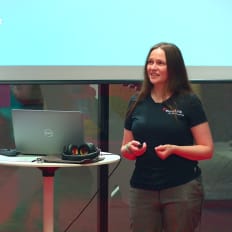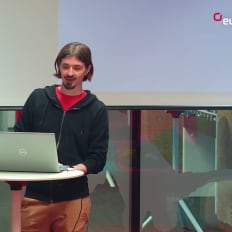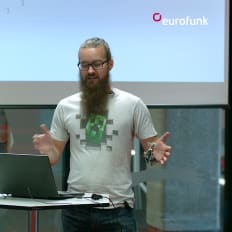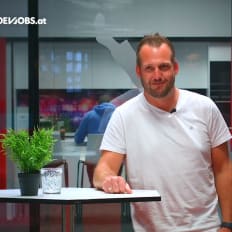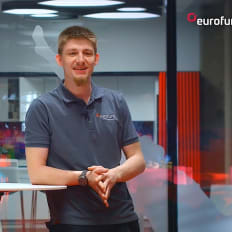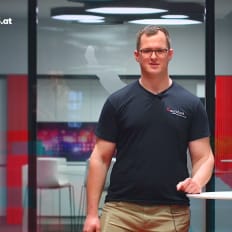
eurofunk Kappacher GmbH
Johanna Blum, Release Train Engineer bei eurofunk Kappacher
Description
Johanna Blum von eurofunk Kappacher beleuchtet im Interview die Teamkultur, die wichtigsten Technologien im Einsatz und die Besonderheiten des Recruiting-Prozesses.
By playing the video, you agree to data transfer to YouTube and acknowledge the privacy policy.
Video Summary
In "Johanna Blum, Release Train Engineer bei eurofunk Kappacher," Speaker Johanna Blum outlines a SAFe-based setup with three trains; her ~70-person train runs six cross-functional teams across a broad stack (Java, C#, C++, Python, Kubernetes) and even an in-house hardware prototyping team, supported by Jira and Confluence. Candidate expectations center on hands-on tryout days: Scrum Masters and POs run test retrospectives, developers complete a small task and meet the team, and hiring weighs technical skills, working style, and personal fit. Looking ahead, a new AI-focused team will add voice support to better assist dispatchers within the product.
Scaling SAFe, cross-functional teams, and an AI-powered horizon: Insights from “Johanna Blum, Release Train Engineer bei eurofunk Kappacher”
Why this session stands out for engineers and tech talent
We listened to “Johanna Blum, Release Train Engineer bei eurofunk Kappacher” and came away with a crisp view of how large-scale engineering actually operates when structure and collaboration align. The highlights: a development organization run on the SAFe framework, six cross-functional teams within a ~70-person Agile Release Train, a tech stack that spans Java, C#, C++, Python and Kubernetes—and even a dedicated hardware prototyping team. Hiring and onboarding are role-specific and hands-on, and the roadmap points to a “smart” team focusing on AI technologies, including voice support to assist dispatchers.
Blum sets the scene clearly:
“Ich bin Release Train Engineer. Bei uns ist die Entwicklungsabteilung nach dem Safe Framework organisiert. Die Softwareentwicklung passiert in drei Trains.”
This foundation shapes the culture, the way teams work together, and what’s expected from candidates. In this recap, we capture what we learned from the session and why the setup at eurofunk Kappacher GmbH is compelling for engineers who want impact, clarity, and scale.
From Train to teams: ~70 people, six teams, explicit roles
Blum leads one of three Trains in the development organization. That Train comprises around 70 people and is organized into six teams that bring the core roles together:
“Mein Train ist ca. 70 Mann stark. Wir sind derweil in sechs Teams organisiert, die aus Entwicklern, Testern, Scrum Mastern und Product Ownern bestehen.”
This puts value creation where it belongs: inside teams that own development, testing, facilitation, and product accountability. For engineers, it means working close to the product and to decision-making. Interfaces aren’t pushed somewhere “upward”—they’re resolved within the team.
Cross-functional by design
Blum emphasizes the cross-functional principle:
“Unsere Teams sind derweil cross-funktional organisiert. Das heißt, in einem Team sind alle Fähigkeiten zur Softwareentwicklung vorhanden.”
In practice, that means multiple programming languages and testing frameworks coexist within the same team, and Scrum Masters and Product Owners are integral team members. The result: faster decisions and a shared sense of responsibility. It also calls for maturity in collaboration, communication, and prioritization—skills that are essential for modern engineering careers.
Technological breadth: software, infrastructure, and hardware prototyping
The stack spans software, infrastructure, and hardware:
- Programming languages: Java, C#, C++, Python
- Infrastructure/Orchestration: Kubernetes clusters
- Additionally: a dedicated hardware prototyping team that designs and develops hardware
“Wir bedienen viele Kunden mit verschiedenen Technologien … wir haben … Java, C-Sharp, C++, Python, Kubernetes-Cluster. Wir haben auch sogar noch eine richtige Hardware-Prototyping-Team, das wirklich Hardware noch selbst entwickelt … was auch jetzt nicht mehr so typisch ist.”
For employer branding, this is notable: it’s rare to find software development, distributed systems, and hardware prototyping under the same roof. Developers can specialize deeply or work at boundaries where software, system integration, and hardware meet. For testers, quality spans different technology types. For Product Owners, it opens a broader product perspective than a single monolith or service landscape.
Tooling that supports collaboration: Jira and Confluence
Day-to-day collaboration is anchored in Atlassian tools:
“Die Tools, die wir zum Managen von unserer Arbeit benutzen, sind eigentlich hauptsächlich Atlassian-Tools, also Jira und Confluence begleiten uns täglich im Arbeiten.”
This suggests transparency through boards, documented decisions, and a shared knowledge base. For newcomers, it accelerates onboarding and makes processes reproducible rather than tribal knowledge.
Hiring and onboarding: role-specific and practical
What stood out most is how eurofunk Kappacher GmbH aligns hiring and onboarding with real role expectations. The flow starts similarly for everyone and then becomes role-specific:
“Es gibt immer zum Start ein Bewerbungsgespräch, ganz normal. Dann werden alle zum Kennenlern-Tag eingeladen.”
From there, it’s all about practical, role-relevant formats.
Scrum Masters: run a trial retrospective
“Scrum Master machen dann bei uns eine kleine Test-Retro … Scrum Master macht eben eine Probe-Retro mit seinem neuen Team, um die Teams kennenzulernen, die neuen Kollegen kennenzulernen.”
This goes beyond assessment. It shows that facilitation, process stewardship, and team dynamics matter day to day. Candidates should be ready to design and lead retrospectives and build trust quickly.
Product Owners: practical team-facing onboarding
Blum notes that the same applies to the PO role: a get-to-know day with a practical component so expectations align both ways and product ownership is experienced rather than stated.
Developers: trial task and team fit
“Die Entwickler beim Schnuppertag kriegen meistens eine kleine Probearbeit, lernen das Team kennen, die potenziellen neuen Kollegen. Und wir schauen einfach, ist der Fit da, einfach auf persönlicher Ebene und auch mit unserer Arbeitsweise und wie wir organisiert sind.”
This is precise in intent: it’s not about coding puzzles for their own sake. It’s about whether the way of working and the organization fit—both technically and personally. Candidates should prepare for realistic tasks, communicate how they work, and engage with the team openly.
Collaboration at scale: what SAFe implies here
Blum makes it clear that development runs under SAFe and value delivery is structured across three Trains. Concretely, it means work is split into manageable units (Trains, teams) while keeping development, testing, facilitation (Scrum Master), and product (PO) closely aligned.
“Die Softwareentwicklung passiert in drei Trains … Unser Train … in sechs Teams organisiert … Unsere Teams sind cross-funktional.”
For talent who come from smaller, less structured contexts, this can be a growth step: learning to navigate, contribute, and lead within systems that connect many people, technologies, and customers. For those seeking scale and clarity, it’s an opportunity to apply their craft in an environment designed for repeatable delivery.
An organization in motion: restructuring and a “smart” team
The status quo is evolving. Blum describes ongoing organizational and technological restructuring:
“Wir machen gerade eine Umstrukturierung durch und auch technologische Umstrukturierung. Also ich bekomme jetzt ein ganz cooles Team dazu, das ja smart sein wird. Da geht es ganz viel um KI-Technologien, die wir in unser Produkt in der Zukunft reinbringen wollen, Sprachunterstützung, alles, was den Disponenten beim Arbeiten unterstützt.”
This is pivotal: the product roadmap includes AI technologies and voice support, aimed at assisting dispatchers. For engineers with an interest in practical AI, it’s a clear signal that real use cases are on the table. Restructuring also implies that processes and responsibilities are in flux—a chance to help shape them.
Why eurofunk Kappacher GmbH is attractive to engineers
Based on Blum’s remarks, we see several concrete reasons to join this environment:
- Wide technology exposure in a real product context: Java, C#, C++, Python, plus Kubernetes clusters and a hardware prototyping team.
- Cross-functional teams that integrate development, testing, Scrum Masters, and Product Owners.
- Deliberate scale: three Trains overall; one Train with roughly 70 people and six teams—large enough for complexity, small enough for focus.
- Atlassian-powered workflows (Jira, Confluence) for transparency and shared knowledge.
- Role-specific hiring and onboarding: trial retro for Scrum Masters, practical formats for POs, trial tasks for developers—each with an emphasis on team and working-style fit.
- A new “smart” team in the making, bringing AI and voice support into the product to help dispatchers do their jobs.
These factors define a setting where hands-on competence matters, responsibilities are clear, and there’s genuine technological breadth.
What candidates should bring
The session hints at expectations we would summarize as:
- Appetite for cross-functional teamwork—working closely with testing, Scrum Masters, and Product Owners.
- Openness to multiple technologies and frameworks; the stack explicitly includes Java, C#, C++, Python, and Kubernetes clusters.
- Willingness to engage in practical hiring formats: trial retrospective (Scrum Master), practical get-to-know (PO), trial task (development).
- A focus on team and working-style fit: not only what you build, but how you work and communicate.
Candidates who align with these points are likely to thrive in Blum’s Train.
What we observed about day-to-day collaboration
Even from a compact session, several collaboration cues stand out directly from Blum’s statements:
- Teams consolidate capabilities rather than fragment them. That shortens decision paths and speeds delivery.
- Scrum Masters and Product Owners aren’t adjacent to teams—they’re inside them, as evidenced by the role-specific practice elements in hiring.
- Tooling (Jira, Confluence) reflects daily work, indicating processes are captured as repeatable workflows.
- The customer and tech mix requires flexibility: “Wir bedienen viele Kunden mit verschiedenen Technologien.”
- Change is expected: “Wir machen gerade eine Umstrukturierung …” points to a learning and adaptation mindset.
Who will find this context most rewarding?
From Blum’s description, natural landing spots include:
- Software engineers who enjoy working across languages (Java, C#, C++, Python) or stepping deeper into Kubernetes-driven environments.
- Test engineers who want to shape quality inside cross-functional teams, including contexts that touch both software and hardware.
- Scrum Masters who like to facilitate real team processes and can demonstrate their approach through a trial retrospective.
- Product Owners who thrive as the team-facing product voice and can make expectations tangible through practical collaboration.
- Talent interested in AI features and voice support—building products that directly assist people in their work, in this case dispatchers.
Applying and onboarding: what to expect
The steps as outlined by Blum translate into a clear checklist:
- Initial conversation: a standard interview to get started.
- Get-to-know day: a shared day to meet the team and see how work happens.
- Role-specific practice:
- Scrum Masters: run a trial retrospective with the prospective team.
- Product Owners: a practical, team-facing session to experience how collaboration works.
- Developers: a small trial task and team meet-and-greet.
- The decision lens: fit—both personal and aligned with the organization’s way of working.
Preparation should focus on real experiences and approaches—not only the outcome, but also how you get there.
Looking ahead: AI to amplify the product
The upcoming “smart” team focused on AI and voice support signals the next product phase. It points to features that simplify interaction and relieve routine work—specifically to support dispatchers. For engineering practice, this will surface questions about data flows, model integration, performance in production, and voice user experience. An organization already comfortable with coordinating large Trains is well positioned to take this step—and it’s a timely opportunity for talent at the intersection of robust engineering and new technologies.
Conclusion: structure, breadth, and momentum—an environment where you can have impact
“Johanna Blum, Release Train Engineer bei eurofunk Kappacher” presents a development organization that blends three strengths: scaled structure (SAFe, Trains, clear roles), technological breadth (Java, C#, C++, Python, Kubernetes, hardware prototyping), and forward-looking product development (AI, voice support for dispatchers). Hiring focuses on practice and team fit—trial retros for Scrum Masters, practical sessions for POs, and realistic tasks for developers. Jira and Confluence underpin daily work.
For tech talent, this is a setting where you work close to the product, share responsibility, and deliver within cross-functional teams alongside testing, Scrum Masters, and Product Owners. With organizational and technological restructuring underway, there’s also a clear invitation to help shape the next chapters. If that blend of stability and forward motion speaks to you, this Train is a compelling place to build and grow.
More Tech Talks
eurofunk Kappacher GmbH From Sound to Sense
Sabine Hasenleithner von eurofunk Kappacher spricht in ihrem devjobs.at TechTalk über die technischen Hintergründe von Sprach Erkennung im Notruf Kontext und zeigt in einer Live Demo eine mögliche Implementierung.
Watch noweurofunk Kappacher GmbH Effortless Versioning
Stefan Höller von eurofunk Kappacher zeigt in seinem devjobs.at TechTalk, wie das Unternehmen die Versionsverwaltung bei langen Produktzyklen mithilfe von Semantic Release gestaltet hat.
Watch noweurofunk Kappacher GmbH Cypress Component Tests
Patrick Pichler von eurofunk Kappacher demonstriert in seinem devjobs.at TechTalk die Herangehensweise des Teams, wie sie Component Tests mit cypress durchführen.
Watch noweurofunk Kappacher GmbH Application Load Testing with k6
Daniel Knittl-Frank von eurofunk Kappacher spricht in seinem devjobs.at TechTalk darüber, wie die hohen Performance Anforderungen der im Unternehmen entwickelten Software erfüllt werden.
Watch now
More Tech Lead Stories
More Dev Stories
eurofunk Kappacher GmbH Viktoria Haselsteiner, Scrum Master bei eurofunk Kappacher
Viktoria Haselsteiner von eurofunk Kappacher spricht im Interview über ihren Einstieg in die Welt von Scrum, welche Fähigkeiten sie dabei als besonders hilfreich erlebt hat und worauf es ihrer Meinung nach in der täglichen Arbeit wirklich ankommt.
Watch noweurofunk Kappacher GmbH Maximilian Spiesmaier, IT Security Consultant bei eurofunk Kappacher
Maximilian Spiesmaier von eurofunk Kappacher teilt im Interview seine Erfahrungen aus der IT Security, welche Herausforderungen er im Arbeitsalltag meistert und wie man am besten in den Beruf startet.
Watch noweurofunk Kappacher GmbH Valentin Zintl, Junior Development Engineer bei eurofunk Kappacher
Valentin Zintl von eurofunk Kappacher erzählt im Interview über seinen Karriereweg, welche Aufgaben ihn täglich erwarten und welche Fähigkeiten besonders für den Einstieg wichtig sind.
Watch noweurofunk Kappacher GmbH Johannes Festi, Trainee Software Development bei eurofunk Kappacher
Johannes Festi von eurofunk Kappacher gibt im Interview Einblicke in den Arbeitsalltag als Software Development Trainee, wie er dazu gekommen ist und was seiner Ansicht nach wichtig für den Einstieg ist.
Watch now

